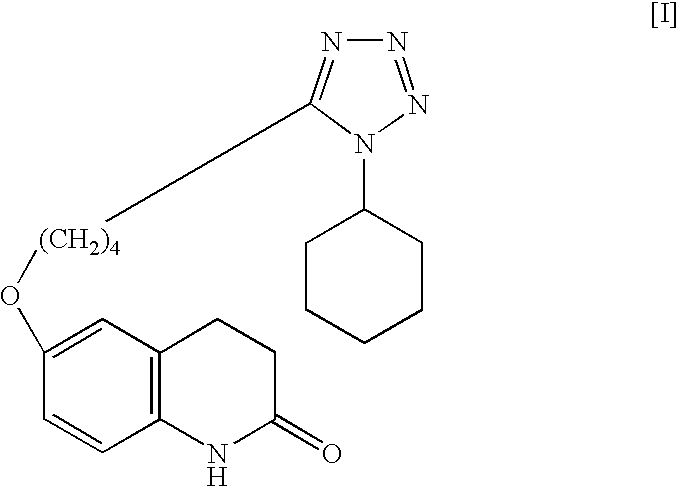Process for production cilostazol
a technology of cilostazol and process, applied in the field of process for producing cilostazol, can solve the problems of unsuitable materials, complicated purification process, and high cost of production of cilostazol with a high purity, and achieve the effects of low cost, high yield and purity
- Summary
- Abstract
- Description
- Claims
- Application Information
AI Technical Summary
Benefits of technology
Problems solved by technology
Method used
Image
Examples
example 1
[0033]Into a reaction vessel having a capacity of 500 mL were introduced 6-hydroxy-3,4-dihydrocarbostyril (30 g, 0.18 mol), 1-cyclohexyl-5-(4-chlorobutyl)-1,2,3,4-tetrazole (49.09 g, 0.20 mol, 1.1 M), potassium carbonate (55.90 g, 0.40 mol, 2.2 M), sodium hydroxide (5.88 g, 0.15 mol, 0.8 M), sodium sulfite (1.5 g, 0.01 mol) and purified water (150 ml). The mixture of the reactants was heated at about 92° C. for about 6 hours with circulating by continuous disperser (pipeline homomixer T.K.ROBO MIX manufactured by TOKUSHUKIKA KOGYO CO. LTD.). After the completion of the reaction, the reaction mixture was cooled to around 50° C., and the mixture was introduced into a flask having a capacity of 1 L, methanol (150 mL) was added thereto and the resulting reaction mixture was refluxed with heating for about 2 hours. The mixture was cooled to the ambient temperature and the precipitated crystalline product was collected by filtration and washed with purified water (150 mL), methanol (90 mL...
example 2
[0034]Into a flask having a capacity of 200 mL were introduced 6-hydroxy-3,4-dihydrocarbostyril (12 g, 0.07 mol), 1-cyclohexyl-5-(4-chlorobutyl)-1,2,3,4-tetrazole (19.64 g, 0.08 mol), potassium carbonate (22.36 g, 0.16 mol), sodium hydroxide (2.35 g, 0.05 mol), sodium sulfite (0.6 g, 0.004 mol) and purified water (60 mL). The mixture of the reactants was heated at about 92° C. for about 6 hours. After the completion of the reaction, the reaction mixture was cooled to around 50° C., and the deposited crude crystals were once collected by filtration. The crystals obtained were introduced into a flask and purified water (120 mL) was added thereto, then the crystals were washed with stirring at about 85° C. for about 15 minutes. The reaction mixture was cooled to around 50° C., and the precipitated crystals were collected by filtration. The crystals obtained were introduced into a flask again and methanol (84 mL) was added thereto, then the crystals were washed with stirring at about 25...
example 3
[0035]Into a reaction vessel having a capacity of 500 mL were introduced 6-hydroxy-3,4-dihydrocarbostyril (30 g, 0.18 mol), 1-cyclohexyl-5-(4-chlorobutyl)-1,2,3,4-tetrazole (49.1 g, 0.20 mol, 1.1 M), potassium carbonate (83.84 g, 0.61 mol, 3.3 M), sodium sulfite (1.5 g, 0.01 mol) and purified water (150 mL). The mixture of the reactants was heated at about 85° C. for about 6 hours with circulating by continuous disperser (pipeline homomixer T.K.ROBO MIX manufactured by TOKUSHUKIKA KOGYO CO. LTD.). After the completion of the reaction, the reaction mixture was cooled to around 50° C. and the deposited crude crystals were once collected by filtration. The crystals obtained were introduced into a flask having a capacity of 1 L and purified water (300 mL) was added thereto, then the crystals were washed with stirring at about 85° C. for about 15 minutes. After washing the crystals, the reaction mixture was cooled to around 50° C. and the precipitated crystals were collected by filtratio...
PUM
| Property | Measurement | Unit |
|---|---|---|
| temperature | aaaaa | aaaaa |
| temperature | aaaaa | aaaaa |
| weight | aaaaa | aaaaa |
Abstract
Description
Claims
Application Information
 Login to View More
Login to View More - R&D
- Intellectual Property
- Life Sciences
- Materials
- Tech Scout
- Unparalleled Data Quality
- Higher Quality Content
- 60% Fewer Hallucinations
Browse by: Latest US Patents, China's latest patents, Technical Efficacy Thesaurus, Application Domain, Technology Topic, Popular Technical Reports.
© 2025 PatSnap. All rights reserved.Legal|Privacy policy|Modern Slavery Act Transparency Statement|Sitemap|About US| Contact US: help@patsnap.com



